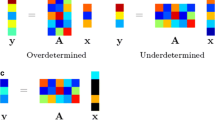Abstract
Photometric stereo is a widely used surface reconstruction method which can estimate surface normals of an object from its images captured under different lighting conditions by a fixed camera. To deal with non-Lambertian reflections efficiently, kernel regression based photometric stereo has been proposed and achieved promising results. However, in practice, different data-sets often require different kernels, and the existing methods need selecting and tuning the predefined kernel manually. This is not user-friendly since it’s hard to find the best kernel for different data-sets. Furthermore, an improper kernel is very likely to degrade the performance. In this work, we adopt multiple kernel learning to handle this problem. The proposed method learns an optimal consensus kernel from multiple predefined kernels by automatically assigning the most suitable weights for different base kernels. The proposed method is tested on various data-sets, and the experiment results show that our multiple kernel based model outperforms the single kernel based method.
Supported by National Major Science and Technology Projects of China (No. 2019ZX01008101), Xi’an Science and Technology Innovation Program (No. 201809162CX3JC4), Natural Science Foundation of Shaanxi Province (CN) (2021JQ-05).
Access this chapter
Tax calculation will be finalised at checkout
Purchases are for personal use only
Similar content being viewed by others
References
Alldrin, N., Zickler, T., Kriegman, D.: Photometric stereo with non-parametric and spatially-varying reflectance. In: 2008 IEEE Conference on Computer Vision and Pattern Recognition, pp. 1–8. IEEE (2008)
Barsky, S., Petrou, M.: The 4-source photometric stereo technique for three-dimensional surfaces in the presence of highlights and shadows. IEEE Trans. Pattern Anal. Mach. Intell. 25(10), 1239–1252 (2003)
Chung, H.S., Jia, J.: Efficient photometric stereo on glossy surfaces with wide specular lobes. In: 2008 IEEE Conference on Computer Vision and Pattern Recognition, pp. 1–8. IEEE (2008)
Coleman, E.N., Jr., Jain, R.: Obtaining 3-dimensional shape of textured and specular surfaces using four-source photometry. Comput. Graph. Image Process. 18(4), 309–328 (1982)
Goldman, D.B., Curless, B., Hertzmann, A., Seitz, S.M.: Shape and spatially-varying brdfs from photometric stereo. IEEE Transactions on Pattern Analysis and Machine Intelligence 32(6), 1060–1071 (2009)
Han, T.Q., Shen, H.L.: Photometric stereo for general brdfs via reflection sparsity modeling. IEEE Trans. Image Process. 24(12), 4888–4903 (2015)
Higo, T., Matsushita, Y., Ikeuchi, K.: Consensus photometric stereo. In: 2010 IEEE Computer Society Conference on Computer Vision and Pattern Recognition, pp. 1157–1164. IEEE (2010)
Ikehata, S., Wipf, D., Matsushita, Y., Aizawa, K.: Robust photometric stereo using sparse regression. In: 2012 IEEE Conference on Computer Vision and Pattern Recognition, pp. 318–325. IEEE (2012)
Ikehata, S., Wipf, D., Matsushita, Y., Aizawa, K.: Photometric stereo using sparse Bayesian regression for general diffuse surfaces. IEEE Trans. Pattern Anal. Mach. Intell. 36(9), 1816–1831 (2014)
Lawrence, J., et al.: Inverse shade trees for non-parametric material representation and editing. ACM Trans. Graph. (TOG) 25(3), 735–745 (2006)
Miyazaki, D., Hara, K., Ikeuchi, K.: Median photometric stereo as applied to the segonko tumulus and museum objects. Int. J. Comput. Vis. 86(2–3), 229 (2010). https://doi.org/10.1007/s11263-009-0262-9
Mukaigawa, Y., Ishii, Y., Shakunaga, T.: Analysis of photometric factors based on photometric linearization. JOSA A 24(10), 3326–3334 (2007)
Ngan, A., Durand, F., Matusik, W.: Experimental analysis of BRDF models. Rendering Techniques 2005(16th), 2 (2005)
Shen, H.L., Han, T.Q., Li, C.: Efficient photometric stereo using kernel regression. IEEE Trans. Image Process. 26(1), 439–451 (2016)
Shi, B., Tan, P., Matsushita, Y., Ikeuchi, K.: A biquadratic reflectance model for radiometric image analysis. In: 2012 IEEE Conference on Computer Vision and Pattern Recognition, pp. 230–237. IEEE (2012)
Shi, B., Tan, P., Matsushita, Y., Ikeuchi, K.: Bi-polynomial modeling of low-frequency reflectances. IEEE Trans. Pattern Analysis Mach. Intell. 36(6), 1078–1091 (2013)
Shi, B., Wu, Z., Mo, Z., Duan, D., Yeung, S.K., Tan, P.: A benchmark dataset and evaluation for non-lambertian and uncalibrated photometric stereo. In: Proceedings of the IEEE Conference on Computer Vision and Pattern Recognition, pp. 3707–3716 (2016)
Woodham, R.J.: Photometric method for determining surface orientation from multiple images. Opt. Eng. 19(1), 191139 (1980)
Wu, L., Ganesh, A., Shi, B., Matsushita, Y., Wang, Y., Ma, Y.: Robust photometric stereo via low-rank matrix completion and recovery. In: Kimmel, R., Klette, R., Sugimoto, A. (eds.) ACCV 2010. LNCS, vol. 6494, pp. 703–717. Springer, Heidelberg (2011). https://doi.org/10.1007/978-3-642-19318-7_55
Wu, T.P., Tang, K.L., Tang, C.K., Wong, T.T.: Dense photometric stereo: a Markov random field approach. IEEE Trans. Pattern Anal. Mach. Intell. 28(11), 1830–1846 (2006)
Yu, C., Seo, Y., Lee, S.W.: Photometric stereo from maximum feasible Lambertian reflections. In: Daniilidis, K., Maragos, P., Paragios, N. (eds.) ECCV 2010. LNCS, vol. 6314, pp. 115–126. Springer, Heidelberg (2010). https://doi.org/10.1007/978-3-642-15561-1_9
Author information
Authors and Affiliations
Corresponding author
Editor information
Editors and Affiliations
Rights and permissions
Copyright information
© 2021 Springer Nature Switzerland AG
About this paper
Cite this paper
Wang, Y., Guo, Y., Yang, X., Zhang, X., Wang, F. (2021). Photometric Stereo Based on Multiple Kernel Learning. In: Peng, Y., Hu, SM., Gabbouj, M., Zhou, K., Elad, M., Xu, K. (eds) Image and Graphics. ICIG 2021. Lecture Notes in Computer Science(), vol 12890. Springer, Cham. https://doi.org/10.1007/978-3-030-87361-5_43
Download citation
DOI: https://doi.org/10.1007/978-3-030-87361-5_43
Published:
Publisher Name: Springer, Cham
Print ISBN: 978-3-030-87360-8
Online ISBN: 978-3-030-87361-5
eBook Packages: Computer ScienceComputer Science (R0)




